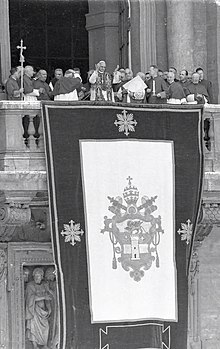1963 papal conclave
| Papal conclave June 1963 | |
|---|---|
| Dates and location | |
| 19–21 June 1963 Giovanni Montini Name taken: Paul VI | |
 | |
A
Papabili
John XXIII's death left the future of the
Participants
The 1963 papal conclave, which met from 19 to 21 June, at the
Balloting

Under the latest rules, election required the votes of two-thirds of those voting, in this case 54.[8] No ballots were taken on the first day, then two each morning and two each afternoon.[9] Because there had been confusion at the last conclave in 1958 over the color of the smoke used to indicate whether a pope had been elected, the smoke would be supplemented with electric lights.[9]
The results of the first four ballots were signaled with black smoke on 20 June at 11:54 am and 5:47 pm. Each time, the smoke appeared white at first.[10]
Some reform-minded cardinals initially voted for
By the fourth ballot on 20 June, according to Time magazine, Montini needed only four more votes to obtain the required number of votes.[citation needed] He was elected on the fifth ballot on the morning of 21 June.[11] When asked by Eugène Tisserant whether he accepted his election, Montini replied, "Accepto, in nomine Domini," ("I accept, in the name of the Lord") and chose the name Paul VI.
At 11:22 am, white smoke rose from the chimney of the Sistine Chapel, signifying the election of a new pope.
Pope Paul VI appeared on the balcony shortly afterwards to give his first blessing. On this occasion, Paul VI chose not to give the traditional Urbi et Orbi blessing but instead imparted the shorter episcopal blessing as his first apostolic blessing.
See also
| Duration | 3 days |
|---|---|
| Number of ballots | 6 |
| Electors | 82 |
| Absent | 2 |
| Present | 80 |
| Italy | 29 |
| Rest of Europe | 26 |
| North America | 7 |
| South America | 11 |
| Africa | 1 |
| Asia | 5 |
| Oceania | 1 |
| DECEASED POPE | JOHN XXIII (1958–1963) |
| NEW POPE | PAUL VI (1963–1978) |
References
- ^ a b Sulzberger, C.L. (19 June 1963). "The News Pope - Two Types of 'Liberal'" (PDF). The New York Times. Retrieved 7 November 2017.
- ^ "Biography of Gregory Petros XV Agagianian". Armenian Catholic Church. Archived from the original on 25 July 2011.
- ^ "Move to Block Soviet Pope Revealed". The Buffalo News. 21 December 1993. Archived from the original on 31 May 2017. Retrieved 16 December 2017.
- ^ Bensi, Giovanni (20 March 2013). "Le due chance perdute del papa armeno". East Journal (in Italian). Retrieved 16 December 2017.; also published in Russian: Bensi, Giovanni (20 March 2013). "Операция "Конклав" (Operation "Conclave")". Nezavisimaya Gazeta (in Russian).
- ^ a b Weigel, George (21 April 2005). "Conclaves: Surprises abound in the Sistine Chapel". Madison Catholic Herald. Retrieved 13 February 2014.
- ^ a b Cortesi, Arnaldo (9 June 1963). "50 Cardinals Join in Rome Meetings" (PDF). The New York Times. Retrieved 7 November 2017.
- ^ "Ecuadorean Cardinal Ill" (PDF). The New York Times. Associated Press. 14 June 1963. Retrieved 7 November 2017.
- ^ a b Cortesi, Arnaldo (19 June 1963). "80 Cardinals Prepare to Enter Conclave Today to Choose Pope" (PDF). The New York Times. Retrieved 7 November 2017.
- ^ a b Cortesi, Arnaldo (20 June 1963). "80 Cardinals Go to Conclave Area to Elect a Pope" (PDF). The New York Times. Retrieved 8 November 2017.
- ^ Cortesi, Arnaldo (21 June 1963). "First Four Votes by Cardinals Fail to Select a Pope" (PDF). The New York Times. Retrieved 8 November 2017.
- ^ a b Cortesi, Arnaldo (22 June 1963). "Cardinal Montini Elected Pope; Liberal, 65, Will Reign as Paul VI; Likely to Continue John's Work" (PDF). The New York Times. Retrieved 8 November 2017.
- ^ Pham, John-Peter. "Heirs of the Fisherman: Behind the Scenes of Papal Death and Succession". Oxford University Press, 2007, pp. 123–4
- Additional sources
- "The Roster of the Membership of the Sacred College of Cardinals" (PDF). The New York Times. 20 June 1962. Retrieved 7 November 2017.
